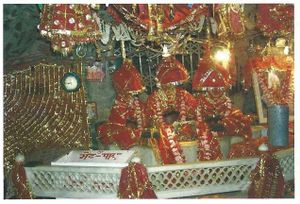Talk:Vaishno Devi
By Swami Harshananda
Significance of Vaishno Devi[edit]
The Vaishno Devi is an important cave temple nestled in the Himālayan ranges of the Jammu region of the Jammu and Kashmir State. It is dedicated to the goddess Durgā in her three aspects of Mahāsarasvatī, Mahālakṣmī and Mahākālī as described in the well-known work, the Durgāsaptaśati or the Candi. The sanctum contains three separate bulbous forms in stone, called Pindis, all rising from the same base stone. The first representing Mahāsarasvatī has a whitish tinge. The second called Mahālakṣmī is yellowish red in color. The last, that of Mahākālī, is black. The whole shrine is in a natural rock form.
Origin of Vaishno Devi[edit]
The origins of this cave shrine are unknown. According to the local legends a pious brāhmaṇa named Paṇḍit Srīdhar lived at the foot of Trikuṭa[1] about 700 years back. Due to his intense devotion and earnest prayers, the Divine Mother had manifested herself as a little girl of extraordinary beauty and had fed a very large crowd of people invited by Srīdhar. This place is now called Bhumikā Mandir. She had also spent nine months in meditation in a cave, now known as the Garbh Joon. When pursued by the demon Bhairon, she beheaded him, assuming the fierce form of Caṇdikā. At the request of the dying demon, she granted the boon that her devotees should also visit the place of his death, where a temple stands now, called as Bhairon Mandir.
Other Nearby Pilgrim Centers[edit]
The other holy places associated with this legend are the Bāṇ Gaṅgā river which is also called as Bāl Gaṅgā produced by the arrow shot by the Mother and the Caraṇapādukā temple containing her footprints on a rock.
Enroute Vaisno Devi[edit]
Pilgrims travel up to the small town of Katra which is 48 kms.[2] from Jammu. The ascent to the cave starts from here, the distance being 12 kms. (7.5 miles). On the way are situated the Bāṇ Gaṅgā temple, the Caraṇapādukā temple and the halfway point called Ardh Kuvari near which is the cave Garbh Joon. The Vaishno Devi temple is situated at a height of 1700 metres (5200 ft.) above the sea-level. It is a cave 30 metres (93 ft.) long and 1.5 metres (5 ft.) high. A lamp is kept burning always. The shrine is kept open round the clock.
Darśana of the Deity[edit]
Pilgrims have to wade through ankle or knee-deep icy water in the cave to have a view of the deity. The movement is by bending and crawling since the height inside the cave does not permit standing. After this, the devotees are expected to visit the Bhairon Temple situated at a distance of 2.5 kms. from the main shrine and at a height of 2010 metres (6700 ft.). Ceremonial worship is done to the goddess twice a day, at sunrise and sunset. Each time it lasts for about two hours. During these periods, pilgrims are not allowed inside.
Festivals[edit]
The main celebrations and festivals are during the Navarātra period in September/October when a Satacaṇdiyāga is organised. Since A. D. 1986, the shrine complex is being ably managed by the ‘Shri Mata Vaishno Devi Shrine Board’.
Facilities at Vaishno Devi[edit]
Facilities provided for the pilgrims include steps, tracks, rest-houses, living rooms, messes providing good food, medical attention, stores and cloakrooms.
References[edit]
- The Concise Encyclopedia of Hinduism, Swami Harshananda, Ram Krishna Math, Bangalore


